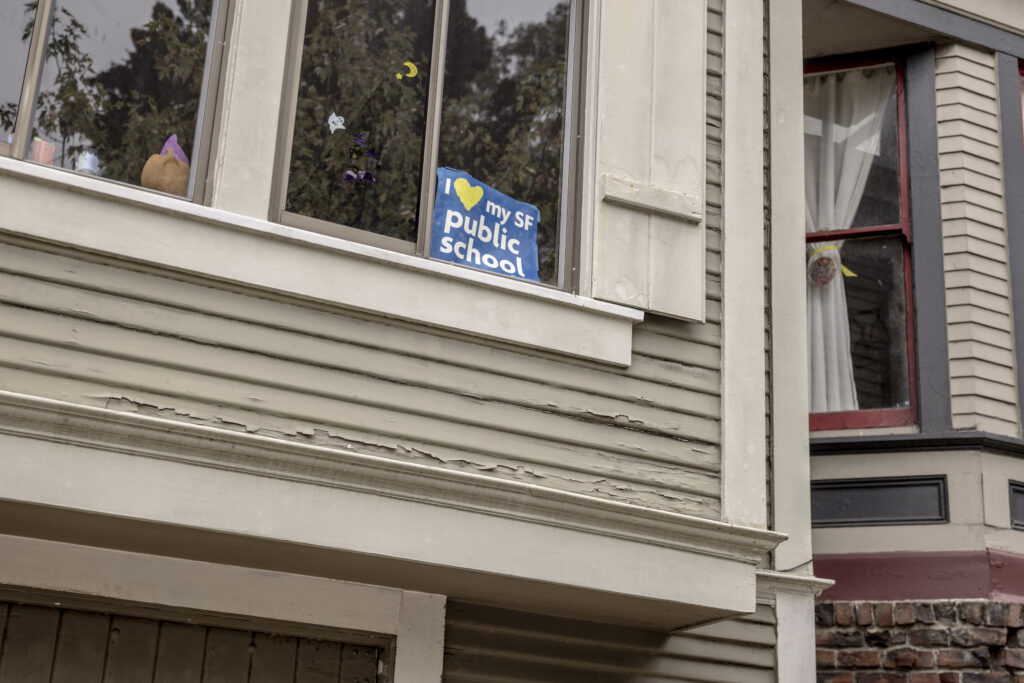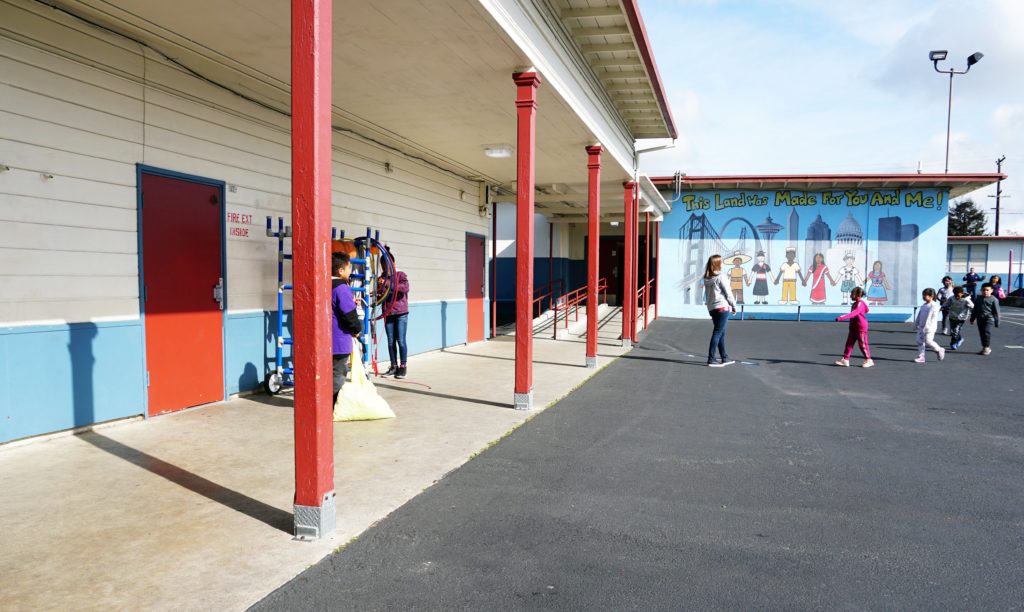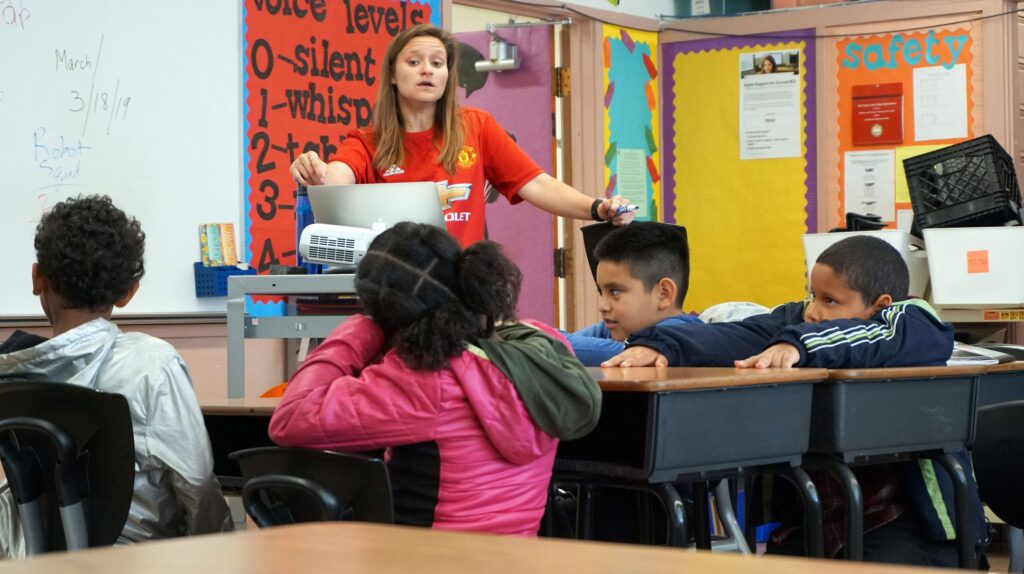
West Contra Costa Unified’s Stege Elementary School in Richmond.
Photo: Andrew Reed/EdSource
West Contra Costa Unified School District is on the cusp of a new and uncertain era following the retirement of its superintendent, Chris Hurst, who stepped down in December after just over three years on the job.
Whoever is chosen to permanently replace him will face a daunting set of concerns, including ensuring that the district is not placed under state control. For now that job is in the hands of interim Superintendent Kim Moses, who until December was the district’s associate superintendent for business services.
With an enrollment of just under 30,000 students, more than half from low-income families, the district comprises 54 schools in El Cerrito, Richmond and other East Bay communities in the San Francisco Bay Area.
Chief among the issues the district faces are declining enrollment, persistent budget deficits, a sluggish improvement in post-Covid test scores, teacher shortages, and meeting the multiple needs of a diverse and largely low-income student body, along with a sometimes-contentious school board not always in alignment with its superintendent.
To a greater or lesser extent, these are problems facing many urban districts across California, including some larger neighbors around the Bay Area.
San Francisco Unified also got a new superintendent last month and is grappling with severe budget deficits and intense pressure to close schools.
While Oakland Unified’s superintendent, Kyla Johnson-Trammell, is still in her job after seven years, surviving a teacher strike, the pandemic, and other travails, the district is dealing with similar profound challenges. Both San Francisco and Oakland also face the prospect of a state takeover.
Last Wednesday, at West Contra Costa’s first board meeting of 2025, Moses issued a blunt warning about the need to make further budget cuts to avoid insolvency.
After making $19 million in cuts during the current year, the district still has a “significant structural deficit,” she said, and warned that under current scenarios, its budget reserves “will be exhausted within three years.”
Without further reductions in the next two school years, the district would be “placed under (state) receivership, which means we’ll no longer be in charge of making financial decisions for our district,” she said.
In 1991, the district had the unfortunate distinction of being the first in the state to go insolvent. To rescue it, the district received a $29 million bailout loan, which took 21 years to pay off. Now it is trying to head off a similar fate.
In December, the West Contra Costa school board passed a budget that members said met the standard to receive a “positive certification,” which under state regulations means it would not spend its entire reserve over the next three years.
But the county office of education has refused to approve that certification without the district providing a multiyear deficit-reduction plan. That is what Moses presented to the board on Wednesday night, involving cuts of $7 million next year, and an additional $6 million the following year.
Declining enrollment — by 8% over the past four years alone — is perhaps West Contra Costa’s primary concern, according to Michael Fine, CEO of California’s Fiscal Crisis and Management Assistance Team, an agency created by the state to help districts resolve financial and management problems.
Fine largely attributes the decline — which is mirrored in many other districts, and the state as a whole — to lower birth rates.
“It’s a long-term problem” for schools, he said. “Right now, schools are feeling it most in kindergarten and elementary school. In 10 years, it will be middle school, then high school.”
The problem translates directly into money. In California, schools have a variety of sources of funds, but they are primarily based on “average daily attendance,” that is, the number of kids in the classroom each day. In 2022-23, the district received nearly $24,000 per student from various sources, most of it from the state based on actual attendance, according to Ed-Data.
As enrollment declines — either through lower birth rates or families leaving the expensive Bay Area — so, too, does the district’s revenues. Another factor reducing income is the end of the federal government’s Elementary and Secondary School Emergency Relief fund, designed to help with Covid-19 recovery. The fund brought the district some $53 million by 2023.
All of which has had an effect on West Contra Costa Unified’s budget.
One approach the district is examining to reduce its deficit is so-called “purpose-based budgeting.” The method, designed to more tightly control expenses, is to evaluate how well specific funds match the district’s priorities.
But that may not be enough.
“Look, I understand. No one joins a school board to lay off people,” Fine says. “But your revenue is going away, and they’re overstaffed compared to their enrollment.”
But Francisco Ortiz, president of United Teachers of Richmond, the union representing teachers, says there are already too many unfilled positions in West Contra Costa, and the district cannot afford to save more by further reducing staff.
“In secondary schools alone, we have 27 vacant FTEs — full-time equivalent (positions),” he says. “And in elementary, it’s 30.8 vacancies and 22 in special ed. The majority of these folks are teachers, some counselors, in elementary, but the majority are classroom teachers.” Most schools, he said, have to use substitutes on a daily basis.
At the board meeting this week, interim Superintendent Moses argued that increasing student attendance and enrollment is the only realistic way to reduce the district’s deficits without making further cuts. For every 1% increase in attendance, the district would generate $2.75 million in additional state funding. To that end, the district is launching what it calls its “Why We Show Up” campaign. “It’s really cut and dried,” Moses said. “We only get revenue based upon the number of children we have in a seat.”
At last week’s board meeting, many parents and teachers expressed concerns that there would be cuts in district offerings like its International Baccalaureate and bilingual and dual immersion programs.
But Moses tried to reassure the school community that no programs would be cut. A big chunk of reductions she is proposing would come from central office reductions, moving teachers out of classrooms with small numbers of students, and so on.
Part of the problem, union leader Ortiz says, is that the district has done a poor job of budgeting for how many teachers it will need each year. As for covering the district’s deficit — to pay for more teachers — he says the district should draw further on its reserve. “The reserve is for a rainy day, and right now it’s flooding. Our most vulnerable students are the ones receiving the blunt end of this. Cutting classroom teachers is not the answer.”
But FCMAT’s Fine argues that has to be part of the equation. “Lots of school boards say cut as far away from the classroom as you can, but when you have declining enrollment, you cut at the classroom level. But it’s really tough. It’s difficult as heck. It is horrendous.”
Fine argues that the issue of teacher vacancies is a nuanced one, and that there may be possible solutions. There may, for example, may be too many English teachers and not enough math teachers, or too many PE teachers and not enough special education teachers. He suggests that districts consider offering programs to re-credential teachers, even though this is not a short-term strategy.
“The solution doesn’t work for everyone, but why don’t we pay, say English teachers, to get credentialed to teach the sixth grade? Or invest in someone to get a special ed credential?”
Before his departure, outgoing superintendent Hurst outlined several of the district’s recent accomplishments in his State of Our District report — a reminder that putting all the attention on finances can obscure progress in other areas.
Among those is the return to 100% in-person learning in the district after the pandemic. Another is “improved staff recruitment, development and retention,” with teacher vacancies declining from 143 two years ago to 64 in the current school year.
Test scores have also improved somewhat in the district, according to results of the Smarter Balanced assessments students took last spring, though they still lag statewide averages, and, like almost all districts in the state, are not yet up to pre-pandemic levels.
The board recently hired David Hart as chief business manager, at least through the remainder of the school year. He’s the highly regarded former chief financial officer of the massive Los Angeles Unified, a district 20 times the size of West Contra Costa. Fine is hopeful Hart’s experience with a vastly more complex district will accelerate the district’s path to recovery.
“They are hiring a very skilled interim CBO,” he said. “I hope they listen to him.”
Louis Freedberg contributed to this report.










